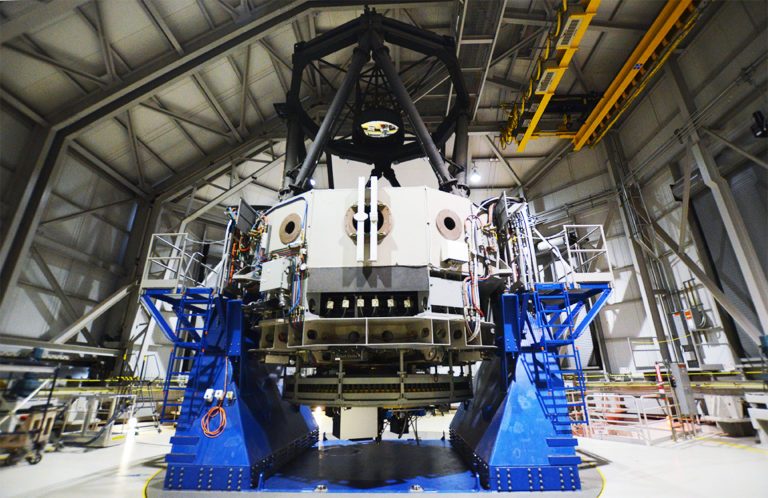
Lowell Discovery Telescope
FOR IMMEDIATE RELEASE
SEPTEMBER 13, 2022
***Contact details appear below
Flagstaff, AZ. – Within two weeks, the DART spacecraft will impact the asteroid moon Dimorphos as it completes the world’s first planetary defense test mission. The success of the effort relies heavily on the Lowell Discovery Telescope, which scientists are using for both before- and after-impact observations.
The DART (Double Asteroid Redirection Test) mission is an outgrowth of ongoing interest in planetary defense, which involves detecting and reducing the threat of potentially hazardous Earth-approaching objects such as asteroids and comets. In recent decades, scientists have carried out surveys to find such bodies. The DART mission addresses the follow-up question of how best to respond to such a potentially hazardous asteroid once it has been identified. Specifically, the mission will demonstrate the ability to deflect such an object away from Earth. This will be achieved by slightly altering the orbit of Dimorphos by impacting it with the DART spacecraft.
“Rock Hammer in Space” Experiment”
Dr. Nick Moskovitz, a planetary astronomer at Lowell Observatory and co-investigator for NASA’s Dart Mission, calls the mission a “rock hammer in space” experiment. He said, “You look at the asteroid now and then you smash it really hard and see what it looks like afterwards.”
Dimorphos measures 170 meters (560 feet) in diameter and will be about 11 million kilometers (8.8 million miles) from Earth on the impact date of September 26. Calculating the path that the spacecraft has to follow to reach such a small body, as well as to determine how much the orbit of Dimorphos changes upon impact, requires highly accurate measurements. This necessitates using some of the most powerful telescopes on Earth, including the Lowell Discovery Telescope (LDT) https://lowell.edu/research/telescopes-and-facilities/ldt/.
The observations are made during so-called mutual events, when Dimorphos passes in front of or behind its parent asteroid Didymos. When these events happen, some of the light reflected from the two bodies is blocked and the brightness drops. By measuring sequential dips in brightness, scientists can determine how long it takes for Dimorphos to orbit Didymos, which allows them to, among other things, calculate the location of Dimorphos for the DART impact.
Dr. Cristina Thomas, a planetary astronomer at LDT partner institution Northern Arizona University and the lead of the observations working group for DART, said, “For the last several years, since this became a mission, one of the biggest contributors of data to DART has been the LDT. With privileged institutional access to the telescope, Nick Moskovitz and our colleagues at the University of Maryland (also an LDT partner) have been able to regularly observe the Didymos-Dimorphos system.”
Dr. Teddy Kareta, a postdoctoral researcher at Lowell Observatory and DART Investigation team member, added, “The capabilities of the LDT make it incredible for just the kind of observations that the DART team will need to find out how their impact experiment has gone.” Kareta and colleagues will also use the LDT in the weeks and months after the impact to watch the ejecta move away from the asteroids.
The team has observed with the LDT on 15 separate nights since 2015. These observations allowed the team to make highly accurate estimates of Dimorphos’s orbital motion. As reported by NASA on August 25 https://www.nasa.gov/feature/dart-team-confirms-orbit-of-targeted-asteroid, observations made in July with LDT, the Magellan Telescope at Las Campanas Observatory, and the Southern Astrophysical Research (SOAR) Telescope, confirmed previous estimates of Dimorphos’ impact-day position.
Moskovitz said, “Thanks to the worldwide effort of observing this system from ground-based telescopes, we know what it looks like before the impact. After impact, we’ll use some of the same techniques, to determine how much Dimorphos has moved and ultimately, how successful we were.”
Lowell Observatory will host a September 26 DART watch party, Earth Strikes Back! NASA’s Planetary Defense Mission: Impact Party. This will include coverage of the DART impact, food trucks, face painting, and more. For details, see https://lowell.edu/event/earth-strikes-back-nasas-planetary-defense-mission-impact-party/.
###
About Lowell Observatory
Lowell Observatory is a private, nonprofit 501(c)(3) research institution, founded in 1894 by Percival Lowell atop Mars Hill in Flagstaff, Arizona. The Observatory has been the site of many important discoveries, including the first detection of large recessional velocities (redshift) of galaxies by Vesto Slipher in 1912-1914 (a result that led ultimately to the realization that the universe is expanding), and the discovery of Pluto by Clyde Tombaugh in 1930. Today, the Observatory’s 14 tenured astronomers use ground-based telescopes around the world, telescopes in space, and NASA planetary spacecraft to conduct research in diverse areas of astronomy and planetary science. Lowell Observatory currently operates multiple research instruments at its Anderson Mesa station, east of Flagstaff, and the 4.3-meter Lowell Discovery Telescope near Happy Jack, Arizona. Prior to the pandemic, the observatory also welcomed more than 100,000 guests per year to its Mars Hill campus in Flagstaff, Arizona, for a variety of educational experiences, including historical tours, science presentations, and telescope viewing.
###
Media Contact
Kevin Schindler, PIO & Historian
Lowell Observatory
kevin@lowell.edu
(928) 233-3210